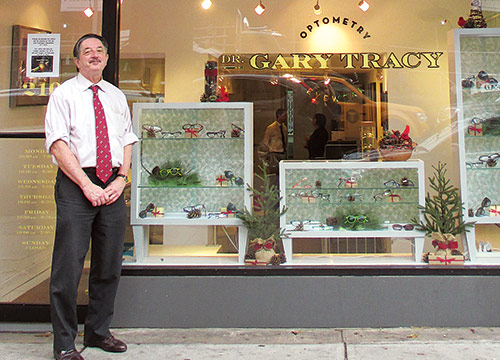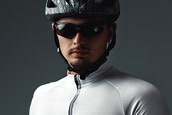
By Cheryl G. Murphy, OD
Although it is not down a rabbit hole, the Upper West Side is somewhat of a wonderland. It is home to many accomplished performers, musicians, artists and authors. Gary Tracy, OD, has been practicing the art of optometry in this New York City neighborhood for over 30 years. Today, he continues to give clear vision to the talented people who work and live there.
Dr. Gary Tracy Optometry and Eyewear is located on 79th Street, a half block west of Amsterdam Avenue. Tracy claims this is the third and final relocation of his office, having started his practice at the first location on a whim in 1974. Even back then he knew the neighborhood was special as he began to meet and serve some extraordinary patients—including John Lennon.
People who work in the performing or creative arts each have unique visual needs. On any given day, an actor’s job may require them to memorize a script, rehearse on set or perform numerous times on stage beneath bright lights. Writers may be working on laptops, appearing at book signings or in meetings with agents or publishers. Some musicians are seated when reading sheet music while others stand. One could find an artist working in their studio, a gallery or even outside. Tracy has gained a reputation in the neighborhood for being a “problem solver” when it comes to musicians and their visual needs. He attributes part of his popularity to referrals from others in the arts who have been helped by him in the past, but what is he offering that is so different from any other optometrist?
Tracy has learned to modify the stereotypical refraction to find individualized solutions for his patients. He also likes to take his time, allowing himself 45 minutes for each exam. Through the years, this generous timing has also allowed him to connect with many artists and performers in the area, and build loyal and genuine relationships with them.
The use of modified exam techniques can help optometrists successfully tailor measurements and products to meet the needs of artists’ eyes. Offering unique frame styles and lines that aren’t available “just anywhere” can also help set a practice apart from cookie-cutter opticals and attract patients who seek not only personalized care but a personalized look.
THINK OUTSIDE OF THE PHOROPTER
Sometimes you have to think outside of the phoropter and measure things in free space. This can be especially true when working with musicians. “If I know a musician is coming in for an exam specifically for glasses that will be used for reading music, I ask them to carefully measure the distance to the music, so I can examine their eyes at that exact distance,” says Tracy.
If they don’t measure the distance, Tracy has a music stand in his exam room to assist. “Several years ago I purchased a music stand so we can place the sheet music at the distance that they have measured. The stand also enables the patient to place the music at any angle that they view to play their particular instrument. When I first started examining patients who were musicians, I used an optical near point card that had musical notes on it, but often heard comments that the patient’s music was not as clear and often on faded sheet music. A few patients started bringing in their own sheet music to show me exactly what they had to view. Whenever they did, I would make a copy of it and kept a portfolio of this ‘authentic’ sheet music, which I would bring out whenever a musician came to me their first time. They would usually be impressed viewing music sheets that they were familiar with, most knowing the piece of music that they are viewing and even humming the notes.”
Different instruments have different lengths, and the angle at which they are held when played varies. Ideally, the working distance of a patient’s near prescription should be measured and not assumed to be standard. Have the patient set themselves up at the music stand while holding their instrument (if they brought it) so they can mimic their posture, viewing angle and working distance properly. Then take the near rod off the phoropter to measure the distance from their eyes to the music and then calculate the reading prescription. Remember this may vary for different musicians, particularly if they are standing like those playing bass or percussion in an orchestra as opposed to sitting. Ask them to play (or pretend to play) and watch them. Note where their eyes glance. Do they ever have to glance at the frets, fingerboard of their violin or down at the strings of their cello? Remember, they may want to clearly see other distances aside from the music stand, like a set list, the conductor or even the audience. Ask them about what occurs during their typical performance so you get to know their movements and visual needs.
Allowing for additional time to think about what lens design will be best for each patient’s glasses is something Tracy recommends. “I usually try the simplest design first. Sometimes a musician (like a pianist) is best served by having a single vision lens set for the sheet music distance,” says Tracy. “The next step (or lens I try) may be ‘the Interview’ or the ‘Office’ that adds a bit more plus at the bottom of the lens, if they also need to view music or print while playing the piano. When these don’t fulfill all of the patient’s needs, we consult with lab technicians who can come up with some clever customized digital solutions.” Talk with the consultant about the different distances the patient needs to view such as the conductor, the sheet music and perhaps different parts of one’s own instrument, and relay to them what part of the lens the patient will be looking through when doing each of those tasks, as well as your working distance measurements.
SET THE STAGE FOR DISTINCTIVE STYLE
Tracy has not only fit John Lennon with some of his iconic frames, he has also helped many patients find stylish frames that are as unique as they are. By choosing to remain “simple and classic,” he has always held a selection of frames that are desirably different.
“When I first opened my office in 1974, I quickly developed a reputation for having unusual, innovative frames. Almost all of my examinations resulted in an eyeglass purchase. There was not nearly the competition for frame sales as there is now, and I had many people come in to view the different lines that I carried. I knew nothing of fashion or designer names at the time, but always selected classic, simple styles for my office,” says Tracy.
“I found that as the Upper West Side developed, NYC optical chains moved into the neighborhood that carried many famous designer brand names. I made a decision that I would favor the classic frame companies that I had preferred and limit the number of designer name frames. Offering these unique frame companies would separate me from the optical chains and the similar products that they tended to carry, as well as allow me the freedom of not having to compete with the pricing structure that the optical chains used.”
Declaration of an Independent
Pressed for more details on his actual frame preferences, Gary Tracy, OD, delivered a wealth
of information. Read it and reap:
"Current frame companies: Sama, SALT and Schnuchel, Kyoto.
Original frame companies: Creazioni Alfa (coolest frames ever), BOIC (British company that
made the Beaufort classic frame—silver or gold metal P3 shapes with tortoise rims), Sir Winston (precursor to Anglo American frames).
I also carried Tart frames as Medicare/Medicaid cheapies: The FDR, the Bryan and the Arnel, ugly tortoise and black zyl frames no one under 50 years old would be caught dead in.
The Arnel has made a comeback in recent years, and savvy frame connoisseurs pay premium prices for the originals.
Two American frame companies from the old days were Shuron and Art Craft that made the metal P3s with cable temples that were popular into the 1980s.
Hope this helps. Let me know if you need any other info. I probably gave you more info that you wanted, but just use what you want."
Besides carrying unique products, Tracy says there are two other ways eyecare professionals can stay ahead of the competition. “We have to give the best personal service that we can. Let the patient know that when they buy a frame, we will service it and do everything we can to make sure they are satisfied with it.” He also suggests considering putting your own name on the frames. “While we are just starting out with our private label frames, we have been pleased with their acceptance. Many longtime patients are excited to see that I now have my own line of frames. Right now two of our most successful frame lines provide selected frames with the private label name on the temples. They are not designed specifically for me, but we carefully select the most appropriate frames for private label. If this works well for us, I will pursue finding a frame manufacturer that will make frames specifically for my practice.”
When asked what the biggest secret to his successful decades serving some of the world’s most gifted people is, Tracy humbly replies, “I just try to take the time to listen to each patient and do what is best for each one of them.”
Even though Tracy’s practice is just a stone’s throw away from Lincoln Center and the Beacon Theatre, there are many fantastically creative people who work and live all over the globe. From large cities like NYC to small towns like Utica, N.Y., (where Tracy is originally from), every patient whether they are performers or office workers can benefit from personalized care given by an attentive, passionate doctor and not to mention the magic that comes from a pair of glasses is just simply “you.” ■











